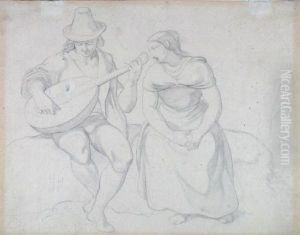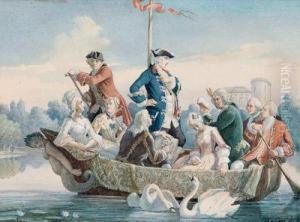Freiherr Von Oer Theobald Paintings
Theobald Freiherr von Oer was a German painter and illustrator, born on April 9, 1807, in Haus Nottbeck in Westphalia, a region that is now part of present-day Germany. His full name, indicating his nobility, was Theobald Reinhold Franz Freiherr von Oer. He was known for his romantic paintings, often infused with a sense of nationalism that was common in the art of the period.
Coming from a noble family, von Oer received a comprehensive education. He began his artistic studies under Johann Christoph Rincklake, a respected painter at the time. Von Oer's early works were influenced by Rincklake's classicist style, but as he matured, he developed a more romantic approach to his subjects. After his initial training, he continued his studies at the Academy of Fine Arts Munich and later went on to the Düsseldorf Art Academy, which was a center for the Romantic movement in Germany.
Throughout his career, von Oer painted various subjects, including history paintings, landscapes, and portraits. His historical paintings often depicted scenes from German literature and mythology, intended to evoke a sense of pride and cultural identity among the German people. This was particularly significant during a period when the German states were not yet unified and there was a strong movement towards establishing a shared national identity.
One of his notable works is the cycle of frescoes in the Hohenzollern Castle, which he worked on from 1844 to 1861. These frescoes showcased events from the history of the House of Hohenzollern, the dynasty that would later become German emperors. The commission was a testament to von Oer's skill and reputation as a painter who could capture the grandeur and spirit of German history.
Von Oer was not just a painter but also an illustrator, contributing to various publications of the time with his detailed engravings and lithographs. His illustrations often accompanied texts that were part of the burgeoning German romantic literary movement.
Freiherr von Oer passed away on March 18, 1885, in Dresden. His work remains a testament to the Romantic era in German art, reflecting the cultural and nationalistic currents of his time. Although not as widely known today as some of his contemporaries, von Oer’s contributions to German art history continue to be recognized by scholars and enthusiasts of the Romantic period.

